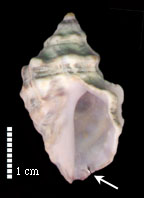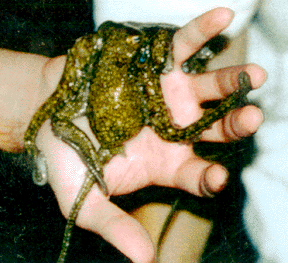
The thorn shell, Acanthina angelica
The phylum Mollusca is the second most diverse phylum after Arthropoda with over 110,000 described species. Mollusks may be primitively segmented, but all but the monoplacophorans characteristically lack segmentation and have bodies that are to some degree spirally twisted (e.g. torsion).
The Phylum Mollusca consist of 8 classes: 1) the Monoplacophora discovered in 1977; 2) the worm-like Aplacophora or solenogasters of the deep sea; 3) the also worm-like Caudofoveata; 4) the Polyplacophora, or chitons; 5) the Pelecypoda or bivalves; 6) the Gastropoda or snails; 7) the Scaphopoda, or tusk shells; and 8) the Cephalopoda that include among others squid and the octopus.
On the left is a member of the very diverse Gastropoda. This particular example is the intertidal snail Acanthina angelica, which subsists by using the thorn like projection of the lip of its shell (arrow) to pry open the barnacle Chthalamus (see Arthropoda).
Acanthina is a member of the Class Gastropoda, whose members are characterized by spiral shells, a fleshy foot, and a rasping organ called a radula. Other gastropods you are likely to see include the sea slugs and hares, limpets, conchs, murex, olive shells, conus, and many others.


